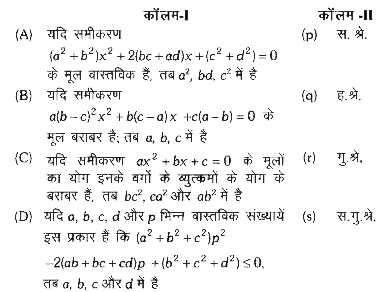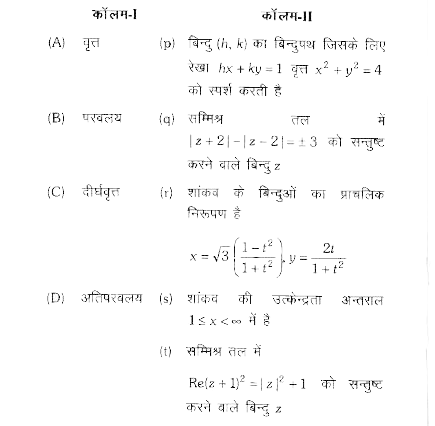यदि θ1,θ2 बिन्दु P से वृत्त x2+y2=a2 पर डाली गयी स्पर्शियों के x-अक्ष से प्रवणता (Slopes) हैं और cotθ1+cotθ2=c, तो P का बिन्दुपथ है
c(x2−a2)=2xy
c(x2−a2)=y2−a2
c(y2−a2=2xy
इनमें से कोई नहीं
The correct Answer is:C
Step by step video, text & image solution for यदि theta_(1), theta_(2) बिन्दु P से वृत्त x^(2) + y^(2) = a^(2) पर डाली गयी स्पर्शियों के x-अक्ष से प्रवणता (Slopes) हैं और cot theta_(1)+cot theta_(2)=c, तो P का बिन्दुपथ है by Maths experts to help you in doubts & scoring excellent marks in Class 12 exams.
Topper's Solved these Questions
- BOOK - ERRORLESS HINDICHAPTER - वृत्त तथा वृत्तों का निकाय EXERCISE - JEE Advanced (More than one correct answers)28videos
वृत्त तथा वृत्तों का निकाय
- BOOK - ERRORLESS HINDICHAPTER - वृत्त तथा वृत्तों का निकाय EXERCISE - JEE Advanced (Reasoning type questions )8videos
वृत्त तथा वृत्तों का निकाय
- BOOK - ERRORLESS HINDICHAPTER - वृत्त तथा वृत्तों का निकाय EXERCISE - Solved Multiple Choice Questions (वृत्त की स्पर्श रेखा तथा अभिलम्ब)72videos
वृत्त तथा वृत्तों का निकाय
- BOOK - ERRORLESS HINDICHAPTER - वर्ग समीकरण एवं असमिकायें EXERCISE - JEE Advanced (Matrix Match type questions)2videos
वर्ग समीकरण एवं असमिकायें
- BOOK - ERRORLESS HINDICHAPTER - शांकव परिच्छेद EXERCISE - JEE Advanced (Matrix Match type questions)7videos
शांकव परिच्छेद
Similar Questions
माना कि L1 मूलबिन्दु से गुजरने वाली एक सरल रेखा है तथा सरल रेखा L2 का समीकरण x+y=1 है। यदि वृत्त x2+y2−x+3y=0 द्वारा L1 और L2 पर काटे गये अन्तःखण्ड बराबर हैं, तो निम्नलिखित में से कौन-सा समीकरण रेखा L1 को निरूपित करता है
05:33View Solutionमाना L1=2x+3y+p−3=0,L2:2x+3y+p+3=0
जहाँ p एक वास्तविक संख्या है तथा C=x2+y2+6x−10y+30=0
कथन-1 : यदि रेखा L1 वृत्त C की जीवा है, तब रेखा L2 सदैव वृत्त C का व्यास नही होगी तथा
कथन-2 : यदि रेखा L1 वृत्त C का व्यास है, तब रेखा L2 वृत्त C की जीवा नहीं होगी।01:35View Solutionरेखा lx+my+n=0 वृत्त x2+y2=a2 की एक स्पर्श रेखा होगी यदि
02:34View Solution 05:58View Solution
05:58View Solution 05:28View Solution
05:28View SolutionIf roots of equation 3x2+5x+1=0are(secθ1−tanθ1)and(cosecθ2−cotθ2). Then find the equation whose roots are (secθ1+tanθ1)and(cosecθ2+cotθ2).
02:51View SolutionIf (acosθ1,asinθ1),(acosθ2,asinθ2) and (acosθ3,asinθ3) represent the vertices of an equilateral triangle inscribed in a circle, then (a) cosθ1+cosθ2+cosθ3=0 (b) sinθ1+sinθ2+sinθ3=0 (c) tanθ1+tanθ2+tanθ3=0 (d) cotθ1+cotθ2+cotθ3=0
05:00View Solutionif tan theta_(1)=k cot theta_(2) then find (cos(theta_(1)-theta_(2)))/(cos(theta_(1)+theta_(2)))=
03:54View Solution(cos(theta_(1)-theta_(2)))/(cos(theta_(1)+theta_(2)))+(cos(theta_(3)+theta_(4)))/(cos(theta_(3)-theta_(4)))=0then(tan theta_(1)*tan theta_(2))/(cot theta_(2)*cot theta_(4))
11:25View SolutionThe equation of locus of the point,tangents from which to y^(2)=4x are such that cot theta_(1)-cot theta_(2)=5, where theta_(1) and theta_(2) are inclination of tangents,is:
08:16View SolutionThe tangents to x^(2)+y^(2)=r^(2) having inclinations theta_(1),theta_(2) intersect at P .If tan theta_(1)-tan theta_(2)=1 locus of P is
05:06View SolutionTwo tangents to the parabola y^(2)=4ax make angles theta_(1),theta_(2) with the x -axis.Then the locus of their point of intersection if cot theta_(1)+cot theta_(2)=c is
03:43View SolutionIf theta_(1),theta_(2) be the inclinations of tangents drawn from point P to the circle x^(2)+y^(2)=a^(2) such that cot theta_(1)+cot theta_(2)=k
04:50View SolutionThe base of a triangle is divided into three equal parts. If θ1,θ2,θ3 be thw angles subtended by these parts at the vertex, then prove that
(cotθ1+cotθ2)(cotθ2+cotθ3)=4cosec2θ202:54View SolutionIf θ1,θ2 are the angles of inclination of
tangents through a point P to the circle
x2+y2=a2 then find the locus of P when
cotθ1+cotθ2=k.07:52View Solution

